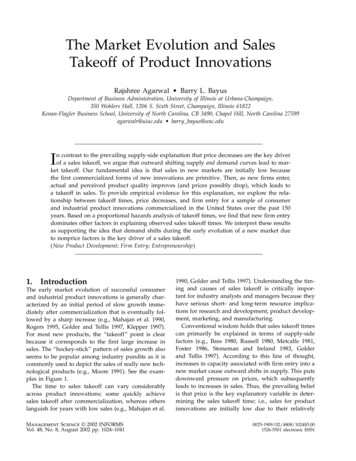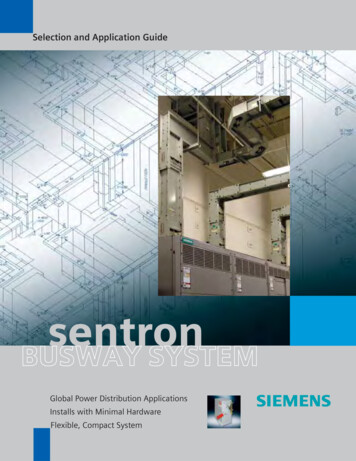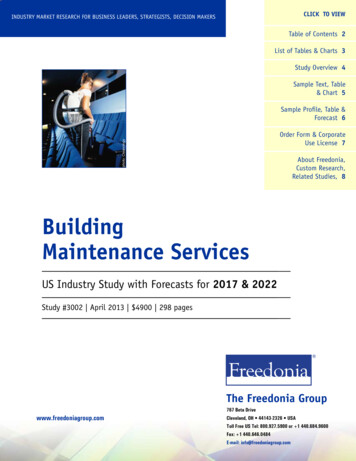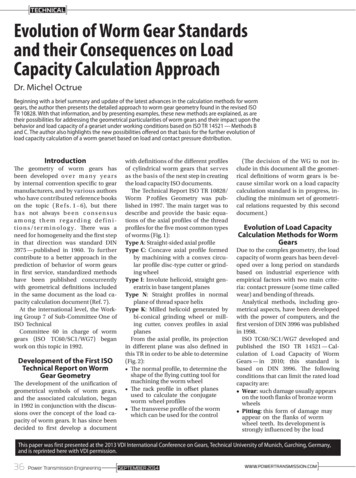
Transcription
The Market Evolution and SalesTakeoff of Product InnovationsRajshree Agarwal Barry L. BayusDepartment of Business Administration, University of Illinois at Urbana-Champaign,350 Wohlers Hall, 1206 S. Sixth Street, Champaign, Illinois 61822Kenan-Flagler Business School, University of North Carolina, CB 3490, Chapel Hill, North Carolina 27599agarwalr@uiuc.edu barry bayus@unc.eduIn contrast to the prevailing supply-side explanation that price decreases are the key driverof a sales takeoff, we argue that outward shifting supply and demand curves lead to market takeoff. Our fundamental idea is that sales in new markets are initially low becausethe first commercialized forms of new innovations are primitive. Then, as new firms enter,actual and perceived product quality improves (and prices possibly drop), which leads toa takeoff in sales. To provide empirical evidence for this explanation, we explore the relationship between takeoff times, price decreases, and firm entry for a sample of consumerand industrial product innovations commercialized in the United States over the past 150years. Based on a proportional hazards analysis of takeoff times, we find that new firm entrydominates other factors in explaining observed sales takeoff times. We interpret these resultsas supporting the idea that demand shifts during the early evolution of a new market dueto nonprice factors is the key driver of a sales takeoff.(New Product Development; Firm Entry; Entrepreneurship)1.IntroductionThe early market evolution of successful consumerand industrial product innovations is generally characterized by an initial period of slow growth immediately after commercialization that is eventually followed by a sharp increase (e.g., Mahajan et al. 1990,Rogers 1995, Golder and Tellis 1997, Klepper 1997).For most new products, the “takeoff” point is clearbecause it corresponds to the first large increase insales. The “hockey-stick” pattern of sales growth alsoseems to be popular among industry pundits as it iscommonly used to depict the sales of really new technological products (e.g., Moore 1991). See the examples in Figure 1.The time to sales takeoff can vary considerablyacross product innovations; some quickly achievesales takeoff after commercialization, whereas otherslanguish for years with low sales (e.g., Mahajan et al.Management Science 2002 INFORMSVol. 48, No. 8, August 2002 pp. 1024–10411990, Golder and Tellis 1997). Understanding the timing and causes of sales takeoff is critically important for industry analysts and managers because theyhave serious short- and long-term resource implications for research and development, product development, marketing, and manufacturing.Conventional wisdom holds that sales takeoff timescan primarily be explained in terms of supply-sidefactors (e.g., Bass 1980, Russell 1980, Metcalfe 1981,Foster 1986, Stoneman and Ireland 1983, Golderand Tellis 1997). According to this line of thought,increases in capacity associated with firm entry into anew market cause outward shifts in supply. This putsdownward pressure on prices, which subsequentlyleads to increases in sales. Thus, the prevailing beliefis that price is the key explanatory variable in determining the sales takeoff time; i.e., sales for productinnovations are initially low due to their relatively0025-1909/02/4808/1024 5.001526-5501 electronic ISSN
AGARWAL AND BAYUSMarket Evolution and Sales Takeoff of Product InnovationsFigure 1The Sales Takeoff of Product Innovationshigh prices. Then, as prices of these products decline,the new product crosses a threshold of affordabilityand sales dramatically take off.In this paper, we argue that this explanation isincomplete. Our fundamental idea is that a sales takeoff is caused by outward-shifting supply and demandcurves.1 Thus, we propose that sales are initially lowdue to the relative primitiveness of the first commercialized forms of new innovations, and increases insales occur as new firms enter the market. Firm entrynot only affects supply but also demand for the product because product improvements, expanded distribution, and increased consumer awareness of brandquality through promotional activities are key ways inwhich entering firms seek to differentiate themselves.We note that this explanation is consistent with findings in the economics and technology literature thatfirm competition in the early stages of new marketgrowth focuses on continual product improvement(e.g., Shapiro 1986, Thomson 1986, Utterback 1994,Klepper 1997, Adner and Levinthal 2001).To provide empirical evidence for this explanation,we examine the role of price decreases and new firmentry in the initial takeoff for a set of consumer andindustrial product innovations commercialized in theUnited States during the last 150 years. While recognizing that firm entry creates additional supplyside capacity, we follow prior research suggestingthat entry in the formative stages of a new market is primarily associated with demand-side changes1See, for example, the reviews in Stoneman (1983), Thirtle andRuttan (1987), and Karshenas and Stoneman (1995).Management Science/Vol. 48, No. 8, August 2002from incremental product improvements and effortsby firms to develop market infrastructure. If entryis only associated with outward shifts in the supply curve, firm entry and price declines should behighly correlated, with each explaining roughly thesame amount of variance in sales takeoff times. Basedon a proportional hazards analysis, we find that pricereductions and new firm entry are significant explanatory variables. However, price reductions account forless than 5% of the variance in sales takeoff timeswhile new firm entry explains almost 50% of thissame variance. We find that price reductions mattermore for products that can be improved with lowR&D costs. We interpret these results as supportingthe idea that demand-side shifts during the early market evolution of new innovations due to nonprice factors is the key driver of the timing of a sales takeoff.The remainder of this paper is organized as follows.In the next section, we present a theoretical framework for the role of firm entry in shifting demandand supply curves, and its impact on the timing of asales takeoff. Section 3 presents an empirical analysisof the early market evolution and the takeoff phenomenon for a set of product innovations. Beginningwith a description of the data sources and sampleof consumer and industrial product innovations, wethen outline our approach for identifying the takeofftimes and present descriptive statistics on key timeintervals and empirical results based on proportionalhazards analyses of takeoff times. Finally, in §4 wediscuss the implications associated with our empiricalfindings, and in §5 we outline several directions forfuture research.1025
AGARWAL AND BAYUSMarket Evolution and Sales Takeoff of Product InnovationsFigure 22.The Evolution of Market Structure for Product InnovationsExplaining the Timingof a Sales TakeoffAlthough our theoretical framework for the role ofprice decreases and incremental product improvements in leading to a sales takeoff can be formalized mathematically, for ease of exposition we presentour ideas in terms of simple supply and demandconcepts. See Agarwal and Bayus (2002) for a moredetailed theoretical framework. Following the industrial organization literature (e.g., see the reviews inGeroski 1991, 1995), we focus on the role of firm entryin shifting the industry supply and demand curves.As suggested by Figure 2, we note that the literature finds a sharp takeoff in the number of firms inthe early stages of market evolution (e.g., Gort andKlepper 1982; Rosegger and Baird 1987; Klepper andGraddy 1990; Utterback and Suarez 1993; Jovanovicand MacDonald 1994; Utterback 1994; Agarwal andGort 1996; Klepper and Simons 1997, 2000). However,this research does not directly consider the sales takeoff phenomenon, as the emphasis is more on explaining the eventual evolution in market structure thatoccurs as an industry matures (Klepper 1997).2As suggested by these studies, firm entry into anew market results in increased capacity. Particularly2Kim et al. (1999) propose a multi-equation diffusion model forsales and the number of competitors. However, their ad hoc modelformulation assumes that an imitation effect within the consumerand firm populations is the only driving force behind marketgrowth, and their empirical analysis of three products does not concentrate on the early stages of market evolution and sales takeoff.1026in the context of new product markets, firm entry alsomay involve an increase in competition or decreasesin production costs due to new process innovations.Concentrating on this supply-side perspective, severalresearchers argue that a price decrease is the key factor leading to a takeoff in sales (e.g., Russell 1980,Foster 1986, Golder and Tellis 1997), and theoreticalresearch concludes that optimal prices are decreasingwhen the supply curve shifts outward (e.g., Bass 1980,Metcalfe 1981, Stoneman and Ireland 1983, Klepper1996). Empirical studies supporting this conclusioninclude Golder and Tellis (1997), who find quick salestakeoff times for new consumer durables that havelow relative prices, and Agarwal (1998) who reportsdeclining price trends for most new consumer andindustrial products.At the same time however, the literature also indicates that firm entry during the early years of market evolution can shift the demand curve outward.Demand increases stem from firm activities in newmarkets that are geared towards increasing actualor perceived product quality.3 As suggested by Gortand Klepper (1982), early entrants often bring crucial3Using methods like hedonic price analysis to account for changesin product quality over time has a long and rich history in theeconomics literature (e.g., see the review in Gordon 1990). However,we do not employ such methods in our study. Aside from the factthat suitable data to conduct these analyses are unavailable for theproduct innovations we study, it is not clear that these methodsare appropriate for the early market time periods of interest to ourresearch. In particular, hedonic analyses can only evaluate qualityimprovements when the product form has stabilized (i.e., the set ofimportant attributes is established), which is not the case during theManagement Science/Vol. 48, No. 8, August 2002
AGARWAL AND BAYUSMarket Evolution and Sales Takeoff of Product Innovationsnew information, skills, and product quality improvements that result in demand increases. This is particularly important because the early commercializedforms of new innovations are generally quite primitive (e.g., Rosenberg 1982, 1994; Shapiro 1986; Thomson 1986; Klepper 1997). Further, as a new marketevolves, the consumer base expands due to increasesin product offerings as well as product differentiation attempts by both new entrants and incumbentsthat respond to the threat caused by new entrants(e.g., Brown 1981, Bayus and Putsis 1999). Severalresearchers note that competition during the earlystages of market growth is primarily on the basis ofcontinued product improvements (e.g., see reviews inGeroski 1991, 1995 and Klepper 1997). Consistent withthis idea, Gort and Konakayama (1982) report a positive and significant relationship between firm entryand the rate of patenting for a sample of seven industrial innovations.4In addition to the above studies examining broadindicators of product quality improvements throughentry across several product markets, detailed evidence of the relationship between early firm entryand product improvements is also available from various industry case studies (e.g., Christensen 1993,Utterback 1994). Consider, for example, the evolutionof major product and process innovations (innovations ranked four or higher on a seven-point scaleby Abernathy et al. 1983) in the automobile industry shown in Table 1. We note that firm entry in thisindustry accelerated only after 1899, and sales of automobiles did not take off until 1909. As discussed inKlepper and Simons (1997), product innovation in theearly evolution of new markets. See Gordon (1990) for a discussionof other pitfalls associated with hedonic analyses.4While patent statistics may seem like an obvious measure of incremental product improvements, they have several limitations. Forexample, innovations vary in their impact on the technologicalenvironment and a count of patents will not necessarily capture thedifferences in the importance of innovations (e.g., Schmookler 1966,Pakes 1985). Gort and Klepper (1982) note that patent counts do notclearly distinguish between product and process improvements, orbetween major and minor innovations. Industries can also differ intheir propensity to patent, due in part to existing trade-offs betweenthe exclusive rights granted by a patent and the loss of secrecy. SeeGriliches (1990) for a general review of patent statistics and theiruse.Management Science/Vol. 48, No. 8, August 2002automobile industry was greatest from commercialization until the first decade of the twentieth century, whereas process innovation was very low duringthis period. More importantly, Klepper and Simons(1997) note that it was new entrants that contributedthe largest share of product innovations, includingthe front-mounted four-cylinder engine, shaft-driventransmission, and pressed steel frame, and caused theautomobile to evolve from its bicycle and carriage origins towards the design of “luxury” cars pioneeredin France. Introduced in 1908, Ford’s Model T represented the culmination of many of these incrementalproduct improvements. Not surprisingly, sales dramatically increased in 1909. The later history of theautomobile industry shows that the majority of process improvements came after 1909, with the mostdramatic improvements in manufacturing occurringafter the sales takeoff, when Ford pioneered the moving assembly line (1913–1914). Klepper and Simons(1997) state that with few exceptions, the industry’smajor process innovations were dominated by thelargest firms (Ford and General Motors). Althoughanecdotal in nature, this example strongly suggeststhat product improvements in the automobile industry occurred during the early years of market evolution when firm entry was high.Studies also indicate that product improvements,relative to process improvements, are typicallyemphasized in the early stages of a new market (e.g.,Abernathy and Utterback 1978; Utterback 1994; Klepper 1996, 1997; Klepper and Simons 1997). Thus, itis not surprising that the dramatic price decreasesdue to declining costs from process improvementsand increasing cumulative sales volume are usuallyobserved only after the sales takeoff (e.g., Bass 1980,Metcalfe 1981, Stoneman and Ireland 1983).In addition to incremental product innovations,demand for the product may also increase fromefforts by incumbents and new firms to increase perceived product quality.5 For example, extensive advertising and promotion may be required to educate andinform potential consumers about the benefits of a5We thank an anonymous reviewer for bringing our attention tofactors associated with new firm entry that may improve perceivedquality of the product innovation.1027
AGARWAL AND BAYUSMarket Evolution and Sales Takeoff of Product InnovationsTable 1YearThe Evolution of Major Product and Process Innovations in the Automobile IndustryFirm1890 King1896Duryea1898Duryea1898ColumbusProduct InnovationProcess InnovationSingle plate clutchAluminum engineEn-bloc engine1st multiple production of one car designInternal-expanding brakesEnclosed car body of wood/steel1899 Number of Firms Takes Off1899PackardAutomatic spark advance1900Most Producers1901Autocar1st shaft-driven Am. car1901Oldsmobile1902Locomobile4-cylinder, front-mounted engine1902Northern3-point suspension of power unit1902NorthernPlanetary gear set1902NorthernIntegral engine and transmission unit1902Marmon1903A.O. SmithPressed steel frame1904FordTorque tube drive1906FordWiring harness for elec. system1907Ford1908FordDetachable cylinder heads1908FordMagneto integrated into flywheel1908Ford1909 Sales Takeoff1910Ford1913Ford1914Ford1914Cadillac (GM)1917Ford1920FordGasoline engine mounted in front1st mass-produced auto1st all metal body (aluminum casting)Multiple simultaneous machining opsVanadium steel components1st branch assembly plantsMoving flywheel-magneto assembly lineElevated moving chassis assembly line1st large scale production of V8 engineBaked enamel finishesContinuous pouring of molten ironSource: Abernathy, Clark, and Kantrow 1983.new product innovation (e.g., the first phonographsbrought the famous opera singer Caruso into yourhome). As suggested by Brown (1981), the timing ofa sales takeoff for a product innovation may alsobe related to the existence and evolution of a market infrastructure; i.e., new firm entry may proxy forinfrastructure development. This infrastructure cantake different forms and might be established in various ways. New distribution channels and pricingarrangements may be necessary for some innovations (e.g., sewing machines required the establishment of new retail outlets as well as credit terms).Widespread adoption of product innovations oftenrequires the development of complementary products1028and services (e.g., automobiles needed roads and gasstations). These fundamental infrastructure developments often take place as a result of new entry intothe market, either as new information is brought inby entrants or as competitive strategies of incumbentsto stave off entry.Thus, based on the discussion so far, new firm entryclearly impacts both the supply and demand of a newproduct innovation. Accordingly, our first hypothesishighlights the importance of new firm entry in thetakeoff of product innovations.Hypothesis H1 . Product innovations with a high(low) level of new firm entry have short (long) takeofftimes.Management Science/Vol. 48, No. 8, August 2002
AGARWAL AND BAYUSMarket Evolution and Sales Takeoff of Product InnovationsWe next address the relative importance ofdemand- and supply-side effects associated withfirm entry as explanatory factors for sales takeoff. The related literature has generally emphasizedsupply-side effects, and thus concludes that pricedeclines are the crucial determinant of sales takeoff (e.g., Golder and Tellis 1997). However, outwardshifting demand and supply results in unambiguously increasing sales but an indeterminate priceeffect. Further, the demand-increasing efforts of firmsmay come at additional costs, which can affect product supply. For example, crucial R&D expendituresin the early years of market evolution may actually increase costs, thereby offsetting effects of outward shifts in supply on price. Thus, the possibility of outward-shifting demand and supply impliesthat sales increases may be associated with eitherhigher or lower prices. Importantly, this ambiguity inprice effects can possibly account for actual industrycases such as turbojet engines, cathode ray tubes, andmicrowave ovens, in which sales took off even thoughprices were increasing.By studying the relationship between pricedecreases, new firm entry, and takeoff times across aset of product innovations, we can explore the roleof shifting supply and demand curves in leading toa sales takeoff. To the extent that supply-side factors alone drive takeoff times, new firm entry willbe associated with greater supply, which in turn willlead to lower prices and a sales takeoff. In this case,the effects of new firm entry on takeoff will operate through price (i.e., new firm entry price takeoff). In addition, price declines and firm entry willbe highly correlated (since firm entry leads to pricedeclines only), which suggests that each variable willseparately account for very similar amounts of variance in observed takeoff times. Thus, we have:Hypothesis H2a . Supply-side effects alone ex
sales takeoff after commercialization, whereas others languish for years with low sales (e.g., Mahajan et al. 1990, Golder and Tellis 1997).Understanding the tim-ing and causes of sales takeoff is critically impor-tant for industry analysts and managers because they have serious short- Cited by: 513Publish Year: 2002Author:











